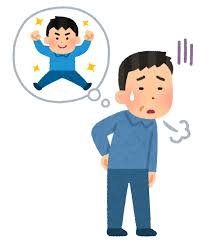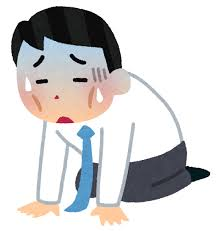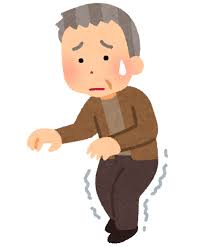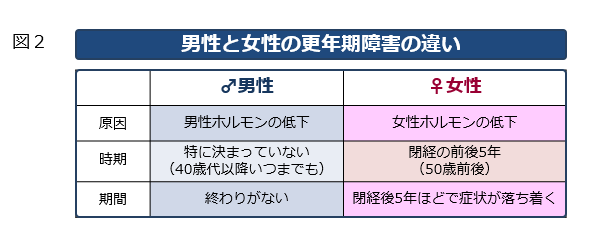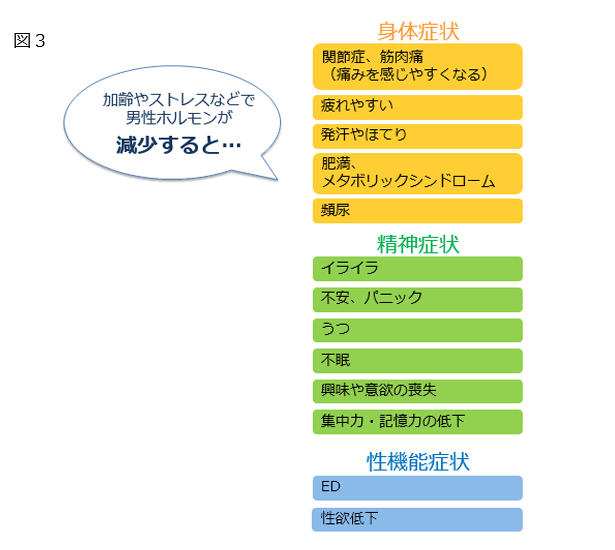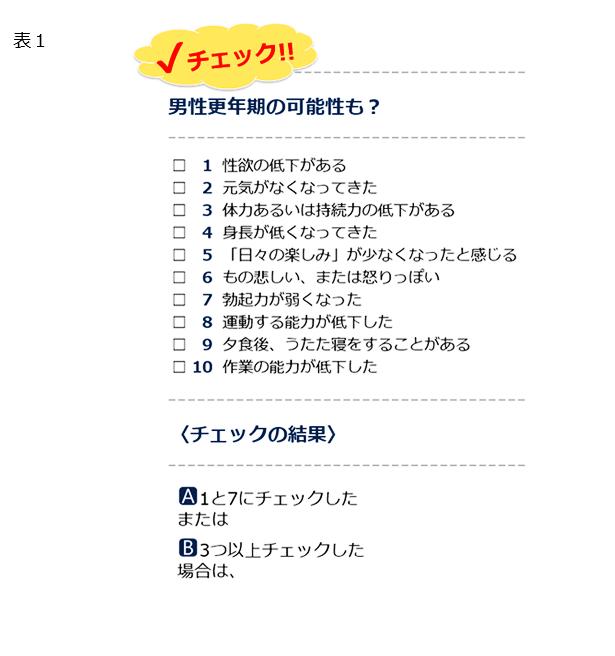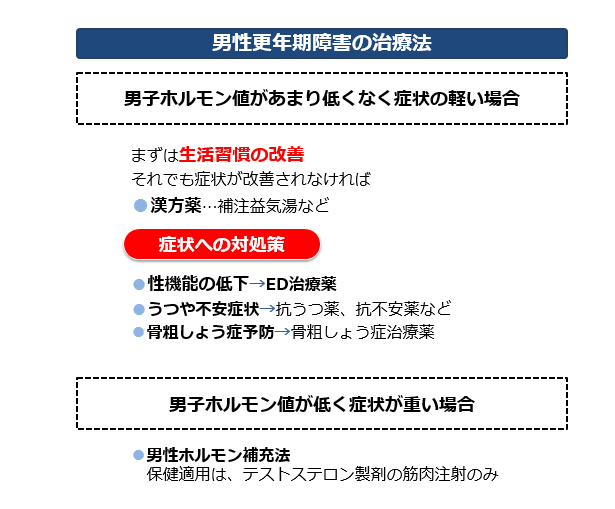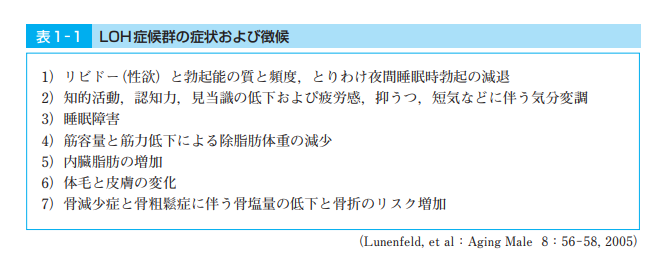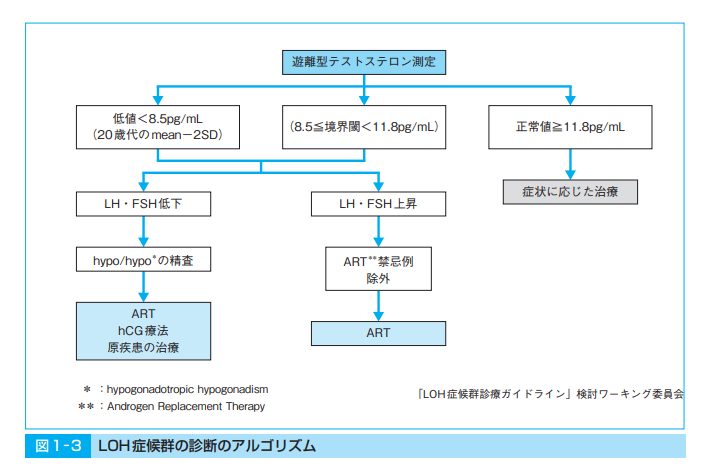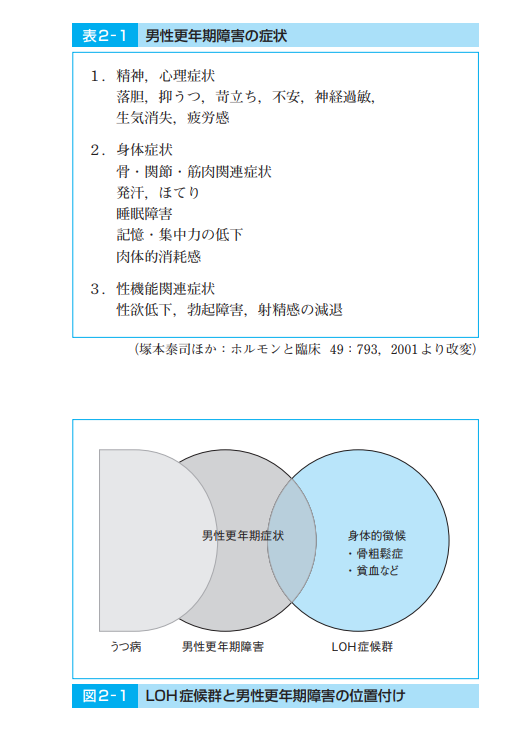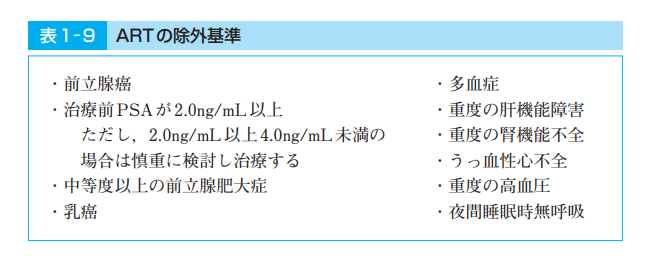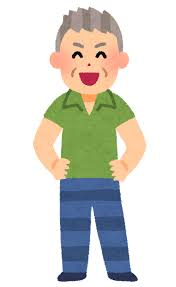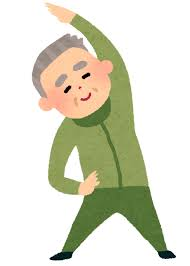よくある質問
Q&A男性・更年期障害とは
更年期障害
「更年期障害」とは、40歳代以降の男女の「性ホルモン分泌量の低下」が原因となる自律神経失調症に似た症候群。男女とも40歳を過ぎた頃から生ずる様々な体調不良や情緒不安定などの症状をまとめ呼称します(厚生労働省より)。女性・更年期障害は周知されていますが、最近「男性・更年期障害」が注視されています。
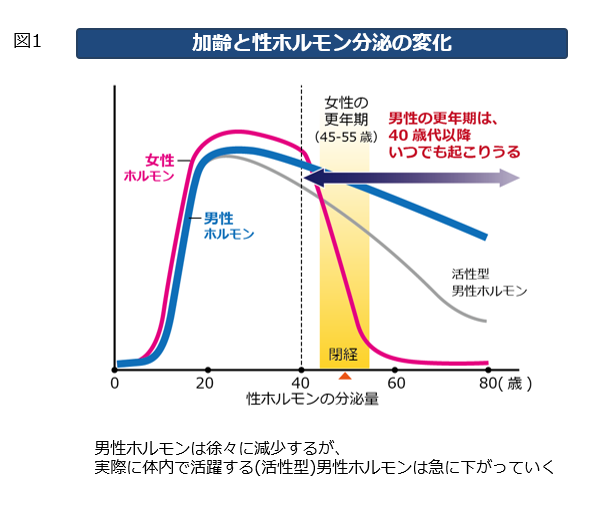
(日本内分泌学会より)
女性の場合は、閉経期前後の約10年間、卵巣ホルモン「エストロゲン」の分泌が急激に減少することにより症状を呈します(図1)。男性の場合は、30歳以降、睾丸ホルモン「テストステロン」の分泌が次第に減少し、40歳代後半にて症状を呈しますが、女性と較べ減少が緩やかなため、老化現象と誤解され、気づかれないことが多いです(図2)。
症状としては自律神経失調症と同様の症状が現れます。女性は閉経前後に、身体症状として、のぼせ・ほてり、動悸や息切、発汗、頻脈、高血圧など、精神症状(心の症状)として、不眠、不安・焦燥、うつ、などです。閉経後はこれらに加え、膀胱炎や尿失禁、腰や膝の関節痛、目や咽喉などの粘膜の乾燥などの身体症状、明らかな抑うつ気分・意欲低下などの身体症状も加わります。男性は…
初期症状が、疲れやすい、体が怠い、よく眠れない、など曖昧であるため、発症に気づかず、普段と異なる自分への不満がさらにストレスとなり、精神症状の悪化するケースが多いです。まず、更年期になる前に症状についての正しい知識と対処方法を認知しておくことが大切です。男性は機能不全(ED)、女性は生理不順も症状として認められることもあります(図3、表1)。
LOH. late-onset hypogonadism
加齢によるアンドロゲンの低下に伴う症状を呈する状態
(加齢男性性腺機能低下症候群診療の手引き より)
漢方薬
八味地黄丸 (ハチミジオウガン):代表的な男性更年期障害の漢方薬。腎気を補う作用があり、腎虚、すなわち精力減退、下半身の機能の衰え全般に効果が期待されるほか、最近では糖尿病や高血圧に伴う症状にも効果が期待されています。
竜骨 (リュウコツ)、牡蛎 (ボレイ):ストレスの強い方へ。精神症状が前面に生じている場合は、竜骨、牡蛎という鎮静作用がある成分の入った漢方薬をしばしば使います。竜骨、牡蛎は鎮静作用がある成分です。イライラが強い症例には柴胡加竜骨牡蛎湯 (サイコカリュウコツボレイトウ)、不安が強い症例には桂枝加竜骨牡蛎湯 (ケイシカリュウコツボレイトウ)があり、これらの漢方薬は八味地黄丸と併用処方することもあります。抑うつ傾向が強い場合は、半夏厚朴湯なども使います。
補材:高齢で体力の衰えが目立つ方へ。長い時間をかけて腎気が衰える男の更年期では、体力の消耗も深刻です。体力の衰えが著しい場合は、全身の体力を補う「補剤」を処方します。代表的な補剤といえば補中益気湯 (ホチュウエッキトウ)と十全大補湯 (ジュウゼンタイホトウ)です。
J Endocrinol Invest. 2005;28(3 Suppl):23-7.
Late-onset hypogonadism in the aging male (LOH): definition, diagnostic and clinical aspects
M Schubert 1, F Jockenhövel
Abstract
Late-onset hypogonadism (LOH) is defined by reduced serum testosterone levels (either total testosterone or free testosterone) and the careful exclusion of any form of classical hypogonadism. When the androgen decline associated with advancing age causes detrimental physiological and mental effects, the syndrome is known as symptomatic LOH (SLOH). A detailed medical history and physical examination are the bases of the diagnosis, and should always precede any biochemical investigations. A general screening of men above a certain age for testosterone deficiency is not feasible. Questionnaires may assist in identifying men who suffer from LOH. Common clinical symptoms of SLOH are lethargy, fatigue, decreased sense of well-being, reduced physical and mental activity, diminished libido, increased sweating, depressive mood, reduced muscle and bone mass or even osteoporosis, erectile dysfunction, and mild anemia. When clinical symptoms are present, the laboratory work-up should focus on total testosterone serum levels. Total testosterone levels <200 ng/dl indicate hypogonadism. In cases of testosterone levels between 200 and 400 ng/dl, measurement should be repeated and supplemented by determination of free testosterone, either by appropriate laboratory methods or the calculation of free testosterone index. In case of very low testosterone levels, classical secondary hypogonadism needs to be considered and excluded. For the safety reasons to exclude contraindications of therapy with androgens, and for follow-up investigations during therapy prostate-specific antigen (PSA), hemoglobin and hematocrit are of interest.

